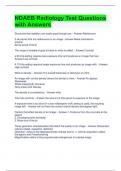Exam (elaborations)
NDAEB Radiology Test Questions with Answers
- Course
- Institution
NDAEB Radiology Test Questions with Answers Structures that radiation can easily pass through are: - Answer-Radiolucent 3 structures that are radiolucent on an image - Answer-Metal restorations enamel dense areas of bone The range of shades of grey to black to white is called: - Answer-Con...
[Show more]



